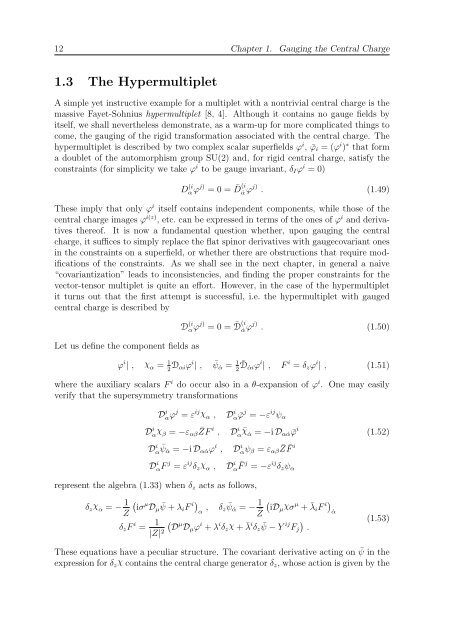N=2 Supersymmetric Gauge Theories with Nonpolynomial Interactions
N=2 Supersymmetric Gauge Theories with Nonpolynomial Interactions
N=2 Supersymmetric Gauge Theories with Nonpolynomial Interactions
You also want an ePaper? Increase the reach of your titles
YUMPU automatically turns print PDFs into web optimized ePapers that Google loves.
12 Chapter 1. Gauging the Central Charge<br />
1.3 The Hypermultiplet<br />
A simple yet instructive example for a multiplet <strong>with</strong> a nontrivial central charge is the<br />
massive Fayet-Sohnius hypermultiplet [8, 4]. Although it contains no gauge fields by<br />
itself, we shall nevertheless demonstrate, as a warm-up for more complicated things to<br />
come, the gauging of the rigid transformation associated <strong>with</strong> the central charge. The<br />
hypermultiplet is described by two complex scalar superfields ϕ i , ¯ϕi = (ϕ i ) ∗ that form<br />
a doublet of the automorphism group SU(2) and, for rigid central charge, satisfy the<br />
constraints (for simplicity we take ϕ i to be gauge invariant, δIϕ i = 0)<br />
D (i<br />
α ϕ j) = 0 = ¯ D (i<br />
˙α ϕj) . (1.49)<br />
These imply that only ϕ i itself contains independent components, while those of the<br />
central charge images ϕ i(z) , etc. can be expressed in terms of the ones of ϕ i and derivatives<br />
thereof. It is now a fundamental question whether, upon gauging the central<br />
charge, it suffices to simply replace the flat spinor derivatives <strong>with</strong> gaugecovariant ones<br />
in the constraints on a superfield, or whether there are obstructions that require modifications<br />
of the constraints. As we shall see in the next chapter, in general a naive<br />
“covariantization” leads to inconsistencies, and finding the proper constraints for the<br />
vector-tensor multiplet is quite an effort. However, in the case of the hypermultiplet<br />
it turns out that the first attempt is successful, i.e. the hypermultiplet <strong>with</strong> gauged<br />
central charge is described by<br />
Let us define the component fields as<br />
D (i<br />
αϕ j) = 0 = ¯ D (i<br />
˙α ϕj) . (1.50)<br />
ϕ i | , χ α = 1<br />
2 Dαiϕ i | , ¯ ψ ˙α = 1<br />
2 ¯ D ˙αiϕ i | , F i = δzϕ i | , (1.51)<br />
where the auxiliary scalars F i do occur also in a θ-expansion of ϕ i . One may easily<br />
verify that the supersymmetry transformations<br />
D i αϕ j = ε ijχ α , D i α ¯ϕ j = −ε ij ψα<br />
D i α χ β = −εαβ ¯ ZF i , D i α ¯χ ˙α = −i Dα ˙α ¯ϕ i<br />
D i α ¯ ψ ˙α = −i Dα ˙αϕ i , D i αψβ = εαβ ¯ Z ¯ F i<br />
D i αF j = ε ij δz χ α , D i α ¯ F j = −ε ij δzψα<br />
represent the algebra (1.33) when δz acts as follows,<br />
δzχα = − 1 µ<br />
iσ Dµ<br />
Z<br />
¯ ψ + λiF i<br />
α , δz ¯ ψ ˙α = − 1 <br />
iDµ<br />
Z¯<br />
χσ µ + ¯ λiF i<br />
˙α<br />
δzF i = 1<br />
|Z| 2<br />
µ<br />
D Dµϕ i + λ i δzχ + ¯ λ i δz ¯ ψ − Y ij <br />
Fj .<br />
(1.52)<br />
(1.53)<br />
These equations have a peculiar structure. The covariant derivative acting on ¯ ψ in the<br />
expression for δz χ contains the central charge generator δz, whose action is given by the

















